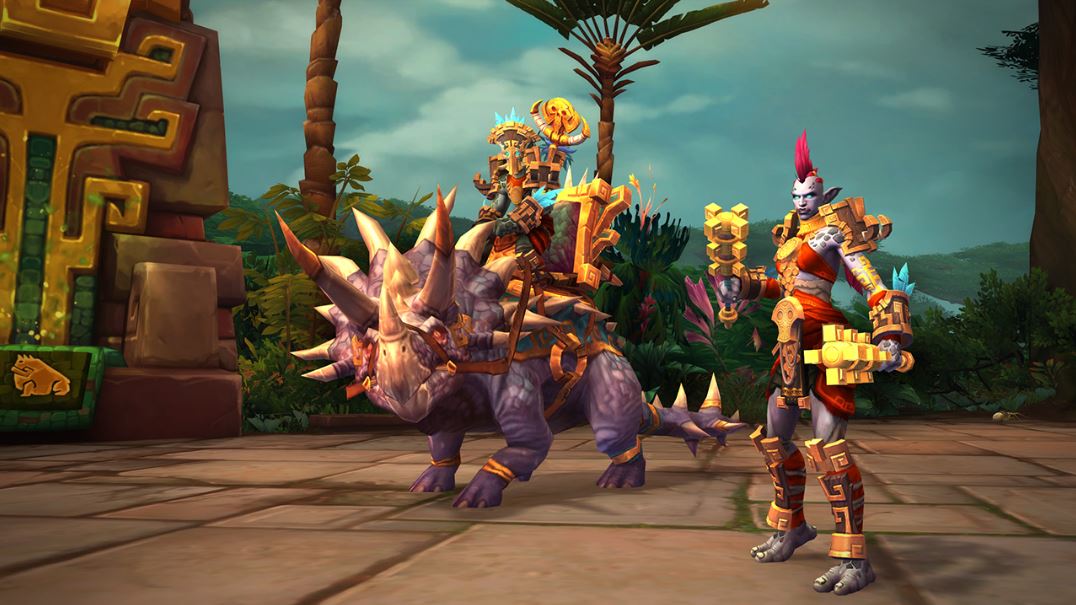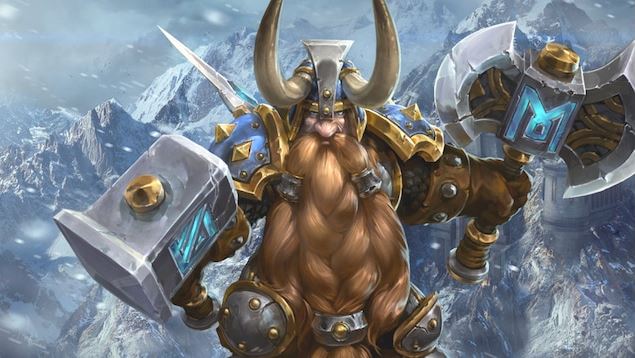Many of you finally breathed fresh air on a summit with Dragonflight. It’s a peak Blizzard hadn’t climbed in a long time. The intimidating mountain, known as “Immersion” in game design, is massive, hard to climb, and shrouded in a mysterious fog. In the player community, no one really knows what to expect up there.
Please follow us on Twitter and Facebook
Are you in the game yourself? Is it more of a feeling that you’re exploring a living world, or perhaps the knowledge of a solid lore behind the actual gameplay? Regardless, you are already looking forward to the amazing world of The War Within, as even Dragon Isles were brimming with immersion. “Out of the way!” it squawks loudly behind you, making you almost jump out of your plate boots in fright.
The Surprising Encounter: Vulpera and the Unexpected Abilities
With the clatter of heavy armor, a Vulpera hops past you, fox ears erect and its face twisted into a predatory grin. “Look at me, I’m a dwarf!” With growing horror, you observe the battered goblin-fox using abilities you last saw with a dwarven Mountain King in Warcraft III. Indeed, it’s specifically the honorable Bronzebeards’ line, inheriting their Titan heritage— “I can shoot lightning, YEEEAH!” snarls the Vulpera, unleashing one ability after another that should be reserved for the mountain kings of Khaz Modan. You slap your face with the gauntlet and sigh heavily. You were looking forward to the expansion, but looking at the whole misery, it can only be a disaster.
Read Also: WoW – Legendary Deception – The Legendary System Stinks To High Heaven
Embracing Change: Hero Specializations and the Joy of Variety
There’s nothing better for motivation than cool new abilities! As a passionate Vulpera player, you’re ecstatic that your cuddly little fur warrior can finally enjoy hero specializations. One moment, you swing your swords in the fur of a mighty butcher. Then, you switch from a Fury Warrior to a Protection Warrior. That’s when it really gets fun! From the Colossus to the Mountain King, the specs offer a lot of variety.

If you get bored with one specialization, you change it with a few clicks. Your fellow players’ grumpy looks don’t bother you, because as long as a feature is fun, it’s well-placed in Azeroth, in your opinion. You wave to the grouchy-looking Earthen Warrior who’s been giving you poisonous glances the whole time. Dwarves in the Horde—how cool is that! You were worried the expansion would be boring, but looking at all the great features, it can only be a success!
My Race, My Class, My Block: Examining the Impact of Choices
With The War Within, for the first time, we’re not getting a single new class but a total of 39 hero specializations. Blizzard saves the development effort of a completely new playstyle. Instead, it offers players the “flair” of a new class. Let’s be honest – who among us isn’t excited about names like “Dark Ranger” or “San’layn”? Not only do the numbers behind our characters change, but the effects in the foreground also seem to change. How extensive these visual delights will be remains to be seen.
The Debate: Quantity vs. Quality in Game Design
However, despite the high number of specializations, the work is significantly less than designing a new core class. Some claim that Blizzard is now going for a literal “quantity over quality” approach, as was the case with Allied Races. You know: no real capital, no elaborate integration into the world. In Dragonflight, we witnessed genuine innovation with the Dracthyr, showcasing how well a “real” race and a “real” class functioned!

The Silver Lining: Examining Choices and Player Preferences
But we’re hitting the brakes here and taking it down a notch. Is it really so bad if players are offered more choices with hero specs? This is without consuming massive amounts of resources, which can now be invested in endgame and evergreen systems. Are Allied Races like the Earthen better than “real” races? Perhaps just because players only care about appearance. Additional features like capitals are completely irrelevant to them.
Read Also: World Of Warcraft Soars To New Heights With Worldwide Dragonriding, Follower Dungeons, And More
In-Depth Analysis: “Dark Ranger” Adjustments and Class Fantasy
After all, the “Dark Ranger” adjustments for elf races were well-received! In this article, we examine the “people and class fantasy” of Azeroth (to the constitutional protection agency: it’s about video games) and their future in WoW. We first explain the relevant systems in a few paragraphs. Then, we address the problem. Finally, we take the opposing position to avoid a one-sided argument. Spoiler alert: It’s not as bad as one might think. Even our old friend “vertical progression” gets a little cameo. Let’s go!
Unveiling the Mechanics: Hero Talent Trees and Specializations
To properly address this, let’s first clarify the basic idea behind hero specializations, which is as simple as it is ingenious: Every base class has had a class talent tree and three specialization talent trees since Dragonflight. With The War Within, each class will soon have three hero talent trees, allowing players to choose a third specialization. These talent trees are usually based on a known hero, concept, or even an enemy from the larger Warcraft universe.
Understanding the Allied Races: A “Lite” Race Concept
Alternatively, some classes may receive a talent tree that doesn’t fit neatly into the existing Warcraft world—the “Fatebound” tree for rogues is a good example, but more on that later. In general, the developers most likely aim to infuse more DNA from the familiar Warcraft universe into an expansion trilogy, leaving classic stories like the Lich King or Illidan far behind and embarking on completely new shores.
The Visual Transformation: Passive Improvements and Aesthetic Enhancements
As explained in the Deep Dive, hero talents generally aren’t active skills, although a new ability may sneak in through the talent trees. Instead, we can expect passive improvements that primarily enhance or modify existing class abilities. A crucial, albeit subtle, detail is that the changes are not only numerical but also visual in nature!
Read Also: Unveiling The Enigmatic “Dynamic Ground Mounts” In Wow Patch 10.2.5
Conclusion: Azeroth’s Diverse Heroes and the Future of WoW
In the “What’s next” panel, it was already observed that warriors with the Mountain King specialization, for example, shoot three projectiles toward enemies instead of just one. During the Deep Dives, attentive viewers noticed that the Druid specialization “Guardians of the Grove” can summon Ents that shoot Moonfire lasers. When triggered, other players ideally recognize the “hero identity” of our characters through the appropriately altered ability.
Epilogue: Allied Races – Streamlining Integration for Efficiency
Explaining the concept of Allied Races is much quicker, as these types have been with us for three expansions already. Since Shadowlands, those who didn’t want to grind the intimidating reputation in Battle for Azeroth have even unlocked these races. In short, Allied Races are a kind of “Lite” race, an “enhanced skin” with a few changed or reissued abilities. Design-wise, they typically involve an existing animation rig with a new texture.

The Balance: Comparing Effort and Integration of Races
Comparing this to the “real” races implemented so far, a clear picture emerges: Blood Elves got their own rig and a capital, as did Draenei, Goblins, Worgen, and Pandaren—latter even got a whole nation. Dark Iron Dwarves, Highmountain Tauren, Mag’har Orcs, and Void Elves? New skins on old rigs. Ironically, this means that Kul Tirans and Zandalari are more like entirely independent races. The bulky humans of Kul Tiras received an entirely new rig and a huge metropolis, while the Zandalari got a wild mix of a Night Elf and a Troll rig. Oh, and a completely built, intricate golden step pyramid… but it still counts. A capital remains a capital!
Read Also: WoW The War Within: All Race And Class Combinations Of The New Expansion
Final Thoughts: The Evolution of Allied Races and the Path Ahead
In general, the approach to Allied Races has become the de facto way for Blizzard to introduce new playable bipeds to Azeroth without exerting massive effort: Dig a little into existing lore, scour a few fan forums and relevant subreddits, and a picture emerges of which fantasy race will be integrated into the game next. While extensive integration into the next expansion can happen, it’s not a necessity.
Acknowledging Innovation: Real Skins as a Future Direction?
This might sound dismissive, but it’s by no means meant that way, as the time savings with this method are absolutely enormous. As mentioned at the beginning, there’s probably only one way to make this process even shorter, and that’s simply introducing real skins: cosmetic changes without new abilities, capitals, or even standalone rigs. The infamous “dark ranger makeup” for various elf races was the first attempt in this direction.
Read Also:
WoW: Dragonflight – A New Gold-Sink Merchant Offers Limited-Time Mount & More





